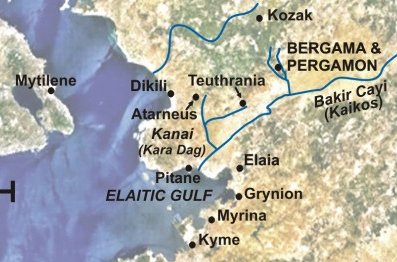Here is one more signpost from the poet of the Iliad which points towards Troy. It lies embedded in the place in Il.21.324-376 where, having trapped many fleeing Trojans at the bend in the river, the killing spree of Achilles made the river god very angry. As the poet explains, in an effort to wash Achilles away downstream and stop the slaughter, Xanthus rose from his bed ‘raging on high and seething with foam and blood and corpses’. Hera saw at once what was about to happen. Alarmed lest Achilles be drowned by the floodwaters bearing down upon him, she called her son to help quell the river by fire. She instructed Hephaestus to ‘manifest much flame’, and ‘…along the banks of Xanthus burn up his trees and set him about with fire…’ Hera, for her part hurriedly ‘roused from the sea a fierce blast’ of wind ‘…that will utterly consume the Trojan dead and their battle gear, spreading on the evil flame;…’ Her plan was successful. First Hephaestus ‘made ready wondrous blazing fire’, burning the dead and making the plain dry ‘and the bright water was stayed.’ And ‘then against the river he turned his gleaming flame’, burning the trees and bushes along the river banks. Burned also was the river. And then Xanthus gave in and agreed to take no further part in the fighting. ‘…and the water boiled; nor had he (Xanthus) any mind to flow further.’

Map showing relative positions of the river mouth and Bergama
Here, what we are especially interested in is the direction from which Hera made the wind blow from the sea. Her intention was to generate a wind blowing towards Troy, which would help spread the flames and dry up the flood and the flooded plain. Now, as Wace and Stubbings wrote in their ‘A Companion to Homer’ (1962, p.283), ‘There are no words in Homer for the points of the compass, but the four winds have names, and their characteristics are differentiated.’ Also, ‘East’ may be indicated by the phrase ‘towards the dawn and the sun’, while ‘west’ may be ‘towards the (misty) gloom’, or some similar phrase.
In our example, in defining the direction from which Hera brought the wind from the sea, the poet had eight choices. In addition to choosing one of the four winds from the main compass points, he could define another four directions if he chose a combination of two winds blowing together. If, as suggested by the evidence, the lower Kaikos valley was the Homeric Trojan plain and Troy was at Bergama, we see that Bergama lies due north-east of the river mouth and the bay of Elaia. To reach the part of the battlefield where Achilles was fighting the Trojans and the river was flooding, the wind from the sea would have to come from the south west. The poet appears to have a one-in-eight chance of choosing a wind direction which supports this theory. He does not disappoint. The winds from the sea summoned by Hera were ‘Zephyrus and bright Notus’, the west and south winds.
This passage thus provides yet further support for Homeric Troy at Bergama. Apart from a very few special exceptions suggested as interpolations, it also helps demonstrate the integrity, in almost every detail, of the geographical and topographical descriptions found in the Iliad.